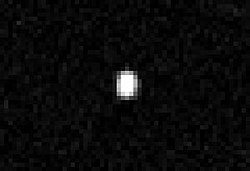50000 Quaoar
 Gambar Quaoar yang diambil dari Teleskop Luar Angkasa Hubble pada tahun 2002 | |
| Penemuan [1] | |
|---|---|
| Ditemukan oleh | C. Trujillo M. E. Brown |
| Situs penemuan | Palomar Obs. |
| Tanggal penemuan | 6 Juni 2002 |
| Penamaan | |
| (50000) Quaoar | |
| Pelafalan | /ˈkwɑːwɑːr/[a] |
Asal nama | Quaoar [2] (deity of the Tongva people) |
| 2002 LM60 | |
| Objek Trans-Neptunus [3] | |
| Ciri-ciri orbit [3] | |
| Epos 27 April 2019 (Hari Julian 2458600.5) | |
| Parameter ketidakpastian 3 | |
| Rentang pengamatan | 64.044 hari (23,376 hari) |
Tanggal precovery terawal | 25 Mei 1954 |
| Aphelion | 43.6916 AU |
| Perihelion | 41.9635 AU |
| 43.6916 AU | |
| Eksentrisitas | 0.0396 |
| 288.81 tahun (105,416 h) | |
| 300.7086° | |
| 0° 0m 12.287s / hari | |
| Inklinasi | 7.9881° |
| 188.8372° | |
| 146.4064° | |
| satelit yang diketahui | 1 (Weywot; D: 81±11 km)[4] |
| Ciri-ciri fisik | |
Diameter rata-rata | 1110±5 km [5] 1074±38 km[6] |
Jari-jari rata-rata | 555±2,5 km [5] |
| Kepepatan | 0,0897±0,006[5] |
| Massa | (1,4±0,1)×1021 kg[6][7] 0.12 Massa Eris [8] |
Massa jenis rata-rata | 1,99±0,46 g/cm3[5] 2,18+0,43 −0,36 g/cm3[6] |
Gravitasi permukaaan ekuator | ≈ 0.3 m/s2 |
Kecepatan lepas ekuator | ≈ 1.83 m/s |
| 17,6788 j[9] | |
| 0,109±0,007[5] | |
| (cukup merah) B–V =0,94±0,01[10] V−R = 0,64±0,01[10] | |
| 19.3[11] | |
| 2,82±0,06[5] 2.4[3] | |
50000 Quaoar adalah objek trans-Neptunus biner dan kandidat planet kerdil yang mengorbit Matahari di sabuk Kuiper. Ia ditemukan pada tanggal 4 Juni 2002 oleh astronom Chad Trujillo dan Michael Brown di California Institute of Technology, dari gambar diperoleh Teleskop Oschin Samuel di Observatorium Palomar.
Catatan[sunting | sunting sumber]
- ^ Brown's website[12] gives a three-syllable pronunciation, /ˈkwɑːoʊwɑːr/, as an approximation of the Tongva pronunciation Templat:IPA-azc. However, his students pronounce it with two syllables, /ˈkwɑːwɑːr/, reflecting the usual English spelling and pronunciation of the deity, Kwawar.[13]
Referensi[sunting | sunting sumber]
- ^ "50000 Quaoar (2002 LM60)". Minor Planet Center. Diakses tanggal 30 November 2017.
- ^ Schmadel, Lutz D. (2007). "(50000) Quaoar". Dictionary of Minor Planet Names – (50000) Quaoar. Springer Berlin Heidelberg. hlm. 895. doi:10.1007/978-3-540-29925-7_10041. ISBN 978-3-540-00238-3.
- ^ a b c "JPL Small-Body Database Browser: 50000 Quaoar (2002 LM60)" (2018-05-25 last obs.). Jet Propulsion Laboratory. Diakses tanggal 27 February 2018.
- ^ Green, Daniel W. E. (22 February 2007). "Satellites of 2003 AZ_84, (50000), (55637), and (90482)". International Astronomical Union Circular. Central Bureau for Astronomical Telegrams. hlm. 1. Bibcode:2007IAUC.8812....1B. Diarsipkan dari versi asli tanggal 19 July 2011.
- ^ a b c d e f Braga-Ribas, F.; Sicardy, B.; Ortiz, J. L.; Lellouch, E.; Tancredi, G.; Lecacheux, J.; et al. (August 2013). "The Size, Shape, Albedo, Density, and Atmospheric Limit of Transneptunian Object (50000) Quaoar from Multi-chord Stellar Occultations". The Astrophysical Journal. 773 (1): 13. Bibcode:2013ApJ...773...26B. doi:10.1088/0004-637X/773/1/26. Diakses tanggal 27 February 2018.
- ^ a b c Fornasier, S.; Lellouch, E.; Müller, T.; Santos-Sanz, P.; Panuzzo, P.; Kiss, C.; et al. (July 2013). "TNOs are Cool: A survey of the trans-Neptunian region. VIII. Combined Herschel PACS and SPIRE observations of nine bright targets at 70-500 µm". Astronomy and Astrophysics. 555: 22. arXiv:1305.0449v2
 . Bibcode:2013A&A...555A..15F. doi:10.1051/0004-6361/201321329. Diakses tanggal 27 February 2018.
. Bibcode:2013A&A...555A..15F. doi:10.1051/0004-6361/201321329. Diakses tanggal 27 February 2018.
- ^ Fraser, Wesley C.; Batygin, Konstantin; Brown, Michael E.; Bouchez, Antonin (January 2013). "The mass, orbit, and tidal evolution of the Quaoar-Weywot system". Icarus. 222 (1): 357–363. arXiv:1211.1016
 . Bibcode:2013Icar..222..357F. doi:10.1016/j.icarus.2012.11.004.
. Bibcode:2013Icar..222..357F. doi:10.1016/j.icarus.2012.11.004.
- ^ Fraser, Wesley C.; Brown, Michael E. (May 2010). "Quaoar: A Rock in the Kuiper Belt". The Astrophysical Journal. 714 (2): 1547–1550. arXiv:1003.5911
 . Bibcode:2010ApJ...714.1547F. doi:10.1088/0004-637X/714/2/1547.
. Bibcode:2010ApJ...714.1547F. doi:10.1088/0004-637X/714/2/1547.
- ^ "LCDB Data for (50000) Quaoar". Asteroid Lightcurve Database (LCDB). Diarsipkan dari versi asli tanggal 2019-01-11. Diakses tanggal 30 November 2017.
- ^ a b Tegler, Stephen C. (1 February 2007). "Kuiper Belt Object Magnitudes and Surface Colors". Diarsipkan dari versi asli tanggal 2006-09-01. Diakses tanggal 27 February 2018.
- ^ "AstDys (50000) Quaoar Ephemerides". Department of Mathematics, University of Pisa, Italy. Diakses tanggal 2009-03-16.
- ^ Frequently Asked Questions About Quaoar
- ^ E. L. Schaller, M. E. Brown, "Detection of Additional Members of the Haumea Collisional Family via Infrared Spectroscopy". AAS DPS conference, 13 Oct. 2008; also podcast: Dwarf Planet Haumea (Darin Ragozzine) at 3′18″
Wikimedia Commons memiliki media mengenai Quaoar.
